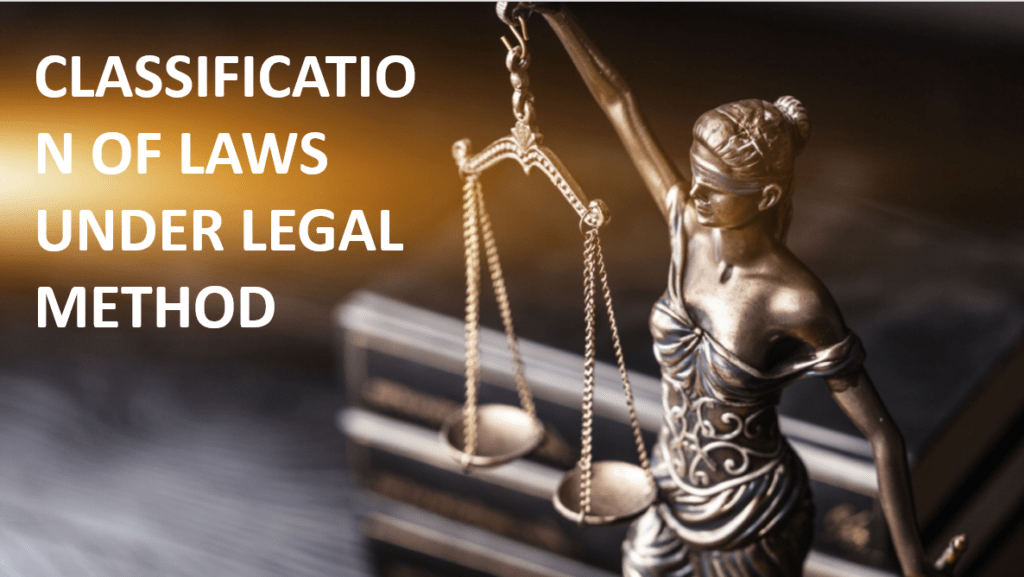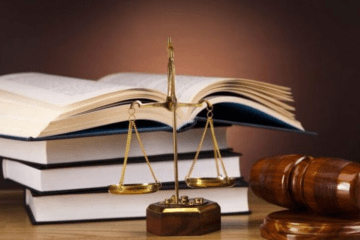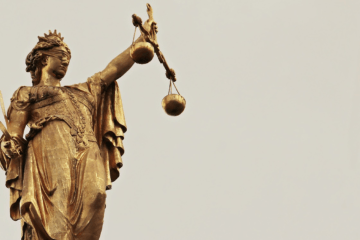
This article is written by Suvanshika Dutta, an intern under Legal Vidhiya
ABSTRACT
In this article, we delve into the complex world of legal techniques by examining the classification of laws. The study explores the foundational structures that influence societies and investigates the different classifications and forms of law that impact legal systems on a global scale. This article seeks to give a thorough overview of the evolution from the traditional civil and criminal law division to the more detailed classifications found in modern legal practice. The exploration covers different aspects of classifying laws, including jurisprudential perspectives, historical evolution, and practical implications. In addition, the article examines how technology and globalization have changed legal classifications and influenced the interaction between statutory, common, and international law. This article aims to provide a deeper understanding of the foundations of legal systems by exploring different layers of law classification. It seeks to facilitate informed discussions on the ever-changing landscape of legal methods.
KEYWORDS: statutes, Administrative procedures, legislature, Administrative procedures, legal methods.
INTRODUCTION
The classification of law is a crucial component within the broader spectrum of legal methods. By categorizing laws based on their nature, scope, and application, legal systems can provide clarity and coherence. This article explores the various classifications of law, shedding light on how this systematic approach contributes to a more organized and effective legal framework. The world of law is a complex tapestry woven from various threads, each representing a distinct aspect of legal methods. Before delving into the classifications of law, it’s essential to grasp the foundational concepts.
DEFINITION OF LAW
Law, in its broadest sense, refers to a system of rules and regulations that govern human behavior within a society. It serves as a framework for maintaining order, resolving disputes, and ensuring justice. Laws are often created by legislatures, interpreted by the judiciary, and enforced by governmental agencies. The dynamic nature of law reflects societal values, evolving with cultural shifts and changes in governance.
WHAT ARE LEGAL METHODS
Legal methods encompass the systematic approaches employed to interpret, apply, and create laws. These methods form the backbone of legal systems worldwide, providing a structured framework for the administration of justice. Legal methods involve legislative processes, judicial interpretations, administrative procedures, and alternative dispute-resolution mechanisms. Understanding legal methods is crucial for legal professionals, scholars, and individuals seeking justice within a society governed by laws. Legal methods constitute the intricate tapestry of systematic approaches employed to interpret, apply, and even shape the very fabric of laws that underpin societies. These methods stand as the foundational backbone of legal systems worldwide, providing a robust and structured framework for the administration of justice. Encompassing various facets, legal methods delve into legislative processes, judicial interpretations, administrative procedures, and alternative dispute resolution mechanisms, collectively guiding the evolution and application of legal principles. In legislative processes, legal methods come into play through the drafting, enactment, and interpretation of statutes. The careful consideration of language, intent, and context becomes paramount in deciphering the legislative will. Judicial interpretations, another integral component, involve the meticulous analysis of precedent, statutes, and legal principles by the judiciary, shaping the development and refinement of legal norms over time. Administrative procedures, within the realm of legal methods, ensure the effective implementation and enforcement of laws. From rulemaking to adjudication, administrative bodies employ systematic methods to navigate complex regulatory landscapes. Additionally, alternative dispute resolution mechanisms, including mediation and arbitration, offer pathways for resolving conflicts outside traditional court settings, showcasing the adaptability and diversity within legal methods. The understanding of legal methods holds profound significance for legal professionals, scholars, and individuals alike, as it unlocks the mechanisms through which justice is sought and dispensed in societies governed by laws. By comprehending these methods, one gains insight into the nuanced processes that not only interpret and apply existing laws but also contribute to the ongoing evolution and adaptation of legal frameworks to the ever-changing dynamics of society. In essence, legal methods stand as guardians of justice, ensuring that the principles upon which societies are built remain dynamic, fair, and reflective of the complexities inherent in the pursuit of a just and equitable legal system.
CLASSIFICATION OF LAW UNDER LEGAL METHODS
Substantive Law and Procedural Law: One foundational classification of law is the division between substantive law and procedural law. Substantive law defines the rights, duties, and obligations of individuals, while procedural law outlines the mechanisms through which these rights are enforced or protected. This distinction is vital for maintaining a balance between legal principles and the practical application of justice.
Public Law and Private Law: Another pivotal classification involves the differentiation between public law and private law. Public law governs the relationship between individuals and the state, encompassing constitutional law, administrative law, and criminal law. Private law, on the other hand, regulates interactions between private entities, including contracts, property law, and family law. This classification helps delineate the spheres of government authority and individual autonomy.
Criminal Law and Civil Law: Within the realms of both public and private law, a significant classification emerges between criminal law and civil law. Criminal law addresses offenses against the state, prescribing punishments for wrongdoing. Civil law, on the contrary, deals with disputes between private parties, aiming to provide remedies rather than punishment. This classification is fundamental for maintaining order in society and ensuring fairness in legal proceedings.
Common Law and Civil Law: Legal systems across the globe often fall into two main classifications: common law and civil law. Common law, developed through judicial decisions and precedents, is prevalent in countries like the United States and the United Kingdom. Civil law, rooted in codified statutes and comprehensive legal codes, is predominant in continental Europe. This distinction influences legal reasoning, the role of courts, and the weight given to legal precedents.
International Law: As the world becomes increasingly interconnected, international law has gained prominence. This classification transcends national borders, governing the interactions between states and international entities. It includes treaties, conventions, and customary international law. The classification of international law is essential for addressing global challenges and fostering cooperation among nations.
Customary Law and Statutory Law: Another important classification lies in the distinction between customary law and statutory law. Customary law evolves from societal practices and traditions, reflecting the unwritten norms accepted by a community over time. In contrast, statutory law is formally written and enacted by legislatures. While customary law often addresses cultural or community-specific matters, statutory law encompasses a broader range of legal issues. Recognizing and balancing the interaction between these two classifications is crucial for a comprehensive legal system.
Hybrid Legal Systems: In some jurisdictions, legal systems may exhibit characteristics of both common law and civil law traditions, resulting in hybrid legal systems. These systems draw on elements from multiple legal traditions, attempting to combine the advantages of each. For instance, mixed legal systems, such as those found in Scotland and Louisiana, incorporate both common law and civil law principles. Understanding these hybrid classifications is essential for legal practitioners navigating diverse legal landscapes.
Transparency, Accessibility, Execution, , Challenges, Role of Technology in Legal Methods.
Transparency in Legal Methods: Transparency in legal methods is essential for upholding the principles of justice and ensuring public trust in legal systems. Legislative processes, for instance, are expected to be transparent, involving public consultations, debates, and open voting. Judicial decisions, too, contribute to transparency when courts provide detailed justifications for their rulings. However, challenges may arise in maintaining transparency, especially in complex legal matters or when dealing with classified information. Continuous efforts to enhance transparency, such as public access to court records and legislative proceedings, contribute to a more accountable legal system.
Accessibility of Legal Methods: The effectiveness of legal methods depends significantly on their accessibility to the general public. Legal systems strive to ensure that laws, court procedures, and dispute-resolution mechanisms are comprehensible to individuals regardless of their legal expertise. Efforts to simplify legal language, provide legal aid services, and promote public legal education contribute to making legal methods more accessible. However, disparities in access to legal resources and representation remain challenges, prompting ongoing initiatives to bridge these gaps and enhance the inclusivity of legal systems.
Execution of Legal Methods: The execution of legal methods involves the practical application of laws and legal principles. This process varies across different classifications of law. In criminal law, for instance, execution involves law enforcement agencies investigating crimes, prosecuting offenders, and carrying out court-ordered punishments. In civil law, execution often takes the form of enforcing contractual obligations or resolving disputes through court-ordered remedies. The effectiveness of execution depends on the collaboration between various components of the legal system, including law enforcement, the judiciary, and administrative bodies. Procedural processes play a crucial role in legal methods, ensuring that laws are applied fairly and consistently. Procedural rules dictate how cases move through the legal system, from initiation to resolution. These processes encompass court procedures, administrative hearings, and alternative dispute resolution mechanisms. Adherence to procedural fairness is fundamental to the legitimacy of legal methods. It includes principles such as the right to a fair trial, due process, and the opportunity to be heard. Procedural rules are designed to safeguard individual rights and provide a structured framework for resolving legal disputes.
Challenges in Legal Methods: While legal methods aim for transparency and accessibility, challenges persist. Complex legal language, lengthy court proceedings, and the cost of legal representation can hinder access to justice. Additionally, the enforcement of legal decisions may face obstacles, especially in cases involving international law or differing legal traditions. Ongoing efforts to address these challenges involve legal reforms, technology integration, and community engagement to create a more efficient and equitable legal landscape.
Role of Technology in Legal Methods: Advancements in technology have significantly impacted legal methods. Online legal databases, e-filing systems, and virtual court proceedings contribute to increased efficiency and accessibility. Technology also facilitates legal research, making legal information more readily available. However, the digital divide poses challenges, requiring strategies to ensure that technological advancements in legal methods benefit all members of society.
Legal methods are intricate processes designed to uphold justice, maintain order, and resolve disputes within a society. While efforts are made to enhance transparency, accessibility, execution, and procedural fairness, challenges persist. Continuous adaptation, legal reforms, and the integration of technology are crucial to improving legal methods and ensuring that they effectively serve the needs of diverse communities. The effectiveness of legal methods varies across jurisdictions, and evaluating their success requires a nuanced analysis. In the context of India, as well as globally, understanding the strengths and challenges of legal methods is crucial for fostering access to justice and promoting a fair and efficient legal system.
LEGAL METHODS IN INDIA AND VARIOUS COUNTRIES
Legal Methods in India: In India, legal methods face a diverse range of challenges. While legislative processes are often transparent, lengthy court proceedings and a backlog of cases contribute to delays in justice. Accessibility is a concern, with disparities in legal representation and limited awareness of rights among certain communities. Initiatives like legal aid services and efforts to simplify legal language aim to enhance accessibility, but further improvements are needed.
Countries with Effective Legal Methods: Several countries are recognized for their effective legal methods, contributing to robust legal systems. Nordic countries like Denmark, Norway, and Sweden are often cited for their efficient legal processes, speedy trials, and strong adherence to the rule of law. Singapore and Japan are notable for their advanced legal technologies, streamlining legal proceedings. Additionally, countries like Canada and Germany have implemented measures to enhance public legal education and representation, contributing to the effectiveness of their legal methods.
Approaches to Enhance Effectiveness:
- Legal Reforms: Continuous legal reforms are essential to address inefficiencies and adapt to evolving societal needs. India, for instance, has undertaken judicial reforms to streamline court processes and reduce case backlogs. Ongoing evaluation of legislative frameworks and procedural rules can contribute to more effective legal methods.
- Technology Integration: Embracing technology is pivotal in enhancing legal methods. Digital platforms for legal research, e-filing systems, and virtual court proceedings can expedite processes and improve accessibility. Investing in technology infrastructure and digital literacy programs can bridge technological gaps and make legal services more inclusive.
- Community Engagement: Building legal awareness within communities is fundamental. Public legal education programs, workshops, and outreach initiatives can empower individuals to understand their rights and navigate legal processes. Collaboration between legal institutions and community organizations can bridge gaps and foster a sense of inclusivity.
- International Collaboration: Learning from successful legal methods in other countries through international collaboration can provide valuable insights. Exchange programs, knowledge-sharing forums, and benchmarking initiatives can facilitate the adoption of best practices and innovative approaches.
The effectiveness of legal methods in India and globally is an ongoing pursuit, requiring a comprehensive approach. Legal reforms, technology integration, community engagement, and international collaboration collectively contribute to building more accessible, transparent, and efficient legal systems. As nations continue to evolve, so too must their legal methods, ensuring that justice remains accessible to all members of society.
How technology and globalization have changed legal classifications?
The intertwining forces of technology and globalization have significantly reshaped the landscape of legal classifications, fostering a complex interplay between statutory, common, and international law. Technological advancements, particularly in communication and information exchange, have blurred traditional jurisdictional boundaries, necessitating a reevaluation of legal frameworks. In the realm of statutory law, the rise of digital transactions and cybercrime has prompted legislators to adapt existing codes or enact new statutes to address challenges in the virtual domain. Issues like data privacy, intellectual property in the digital age, and electronic signatures require constant legal evolution to keep pace with technological developments. Common law, rooted in precedent and judicial decisions, faces the challenge of interpreting statutes in a globalized context. Courts grapple with cases that transcend national borders, requiring a nuanced understanding of international norms and agreements. Technology’s influence on common law is evident in cases involving digital rights, jurisdictional disputes arising from online activities, and the recognition of foreign judgments in the digital realm. Globalization has also catalyzed the growth of international law, transcending traditional boundaries and fostering a more interconnected legal system. Treaties and agreements now address issues like cross-border trade, climate change, and human rights in the context of a globalized world. Technology serves as a catalyst for international legal collaboration, facilitating communication and the harmonization of legal standards. In essence, the dynamic interplay between technology and globalization has propelled legal classifications into a realm where the traditional boundaries between statutory, common, and international law are increasingly porous. Legal systems worldwide are tasked with adapting to this evolving landscape to ensure they remain effective and just in an era defined by rapid technological progress and global interconnectedness.
CONCLUSION
The classification of law is a fundamental aspect of legal methods, providing a systematic framework for understanding the diverse branches of the legal system. Whether delineating between substantive and procedural aspects, public and private spheres, or common and civil law traditions, these classifications contribute to the coherence and effectiveness of legal systems worldwide. As legal systems evolve and adapt to societal changes, an understanding of these classifications remains indispensable for legal practitioners, scholars, and citizens alike. In conclusion, the classification of law, in tandem with the utilization of various legal methods, serves as a foundational pillar in comprehending the multifaceted nature of the legal realm. This systematic categorization is instrumental in providing a comprehensive understanding of the diverse laws that govern different aspects of society. Moreover, the application of legal methods, such as statutory interpretation and case law analysis, contributes to a dynamic and evolving interpretation of legal principles. Statutory interpretation enables a deeper understanding of legislative intent, while the analysis of precedents through case law helps shape legal reasoning and decision-making. These methods not only facilitate a more nuanced grasp of existing laws but also pave the way for adaptability and evolution within the legal system. As we navigate the intricate landscape of legal systems, the classification of law emerges as a guiding compass, ensuring that justice is not only served but also continually refined to meet the evolving needs of our ever-changing society. It is through this systematic approach and the judicious application of legal methods that we can foster a legal framework that remains responsive, equitable, and reflective of the complexities inherent in the societies it seeks to govern.
REFERENCE
https://www.studocu.com/en-za/messages/question/4127413/identify-the-different-sources-of-law-and-the-importance-of-legislation-as-a-source-of-law/https://www.linkedin.com/posts/adv-alok-tiwari-7b235a102_the-role-of-law-in-society-law-is-the-foundation-activity-7120494749752438786-dnbE
https://thelawexpress.com/what-are-the-different-classifications-of-law
Disclaimer: The materials provided herein are intended solely for informational purposes. Accessing or using the site or the materials does not establish an attorney-client relationship. The information presented on this site is not to be construed as legal or professional advice, and it should not be relied upon for such purposes or used as a substitute for advice from a licensed attorney in your state. Additionally, the viewpoint presented by the author is of a personal nature.




0 Comments